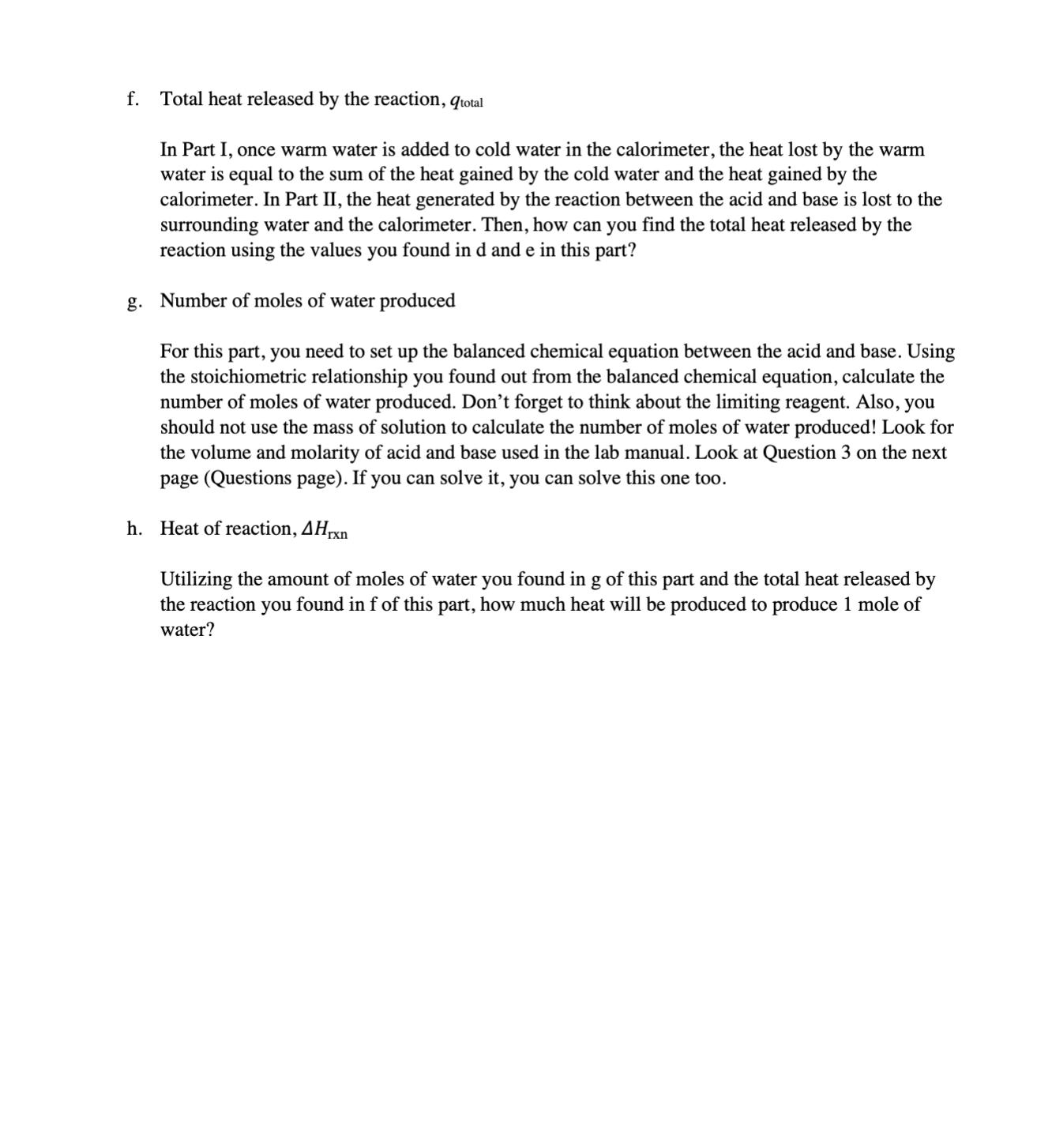Answered step by step
Verified Expert Solution
Question
1 Approved Answer
, we add a strong acid, HCl or H2SO4, to a strong base, NaOH, in the calorimeter. Both the acid and base are diluted


, we add a strong acid, HCl or H2SO4, to a strong base, NaOH, in the calorimeter. Both the acid and base are diluted in water. Once the acid and base are mixed together, the acid and base completely dissociate into ions (ex. NaOH breaks down into Na* and OH) and H* from acid and OH from base combine to generate HO. I would like to note a difference between Part I and Part II. In Part I, heat is transferred from the warm water to the cold water. In Part II, AFTER the acid and base aqueous solutions are mixed, heat is generated/released as the acid and base break down into the ions and water is formed between H+ from acid and OH from base. This heat is gained by the water molecules which were already present in the solutions before the water formation reaction happens. Remember that we use both acid and base which are dissolved in water. There are already a lot more water molecules present before the new water molecules are formed from the reaction between the acid and base. a. T, the temperature of the NaOH and calorimeter before mixing. Data will be collected by you. b. Tf, the temperature of the NaOH and calorimeter after mixing. Data will be collected by you. C. AT cool AT cool = Tf - Ti d. Heat gained by water in the solution after acid is added to base, qwater To find the heat gained by the solution, we need to use equation (7.7) again. qwater AT cool xmX CHO (7.7) In this equation, we still use the specific heat of water because the surrounding water molecules gain heat as the HCl or H2SO4 and the NaOH dissociate into ions and H* and OH combine to form water, releasing heat. Remember that both the acid and base are aqueous solutions which means that these are dissolved in water. Therefore, what is the mass of water AFTER you mix the acid and base with the assumption that the density of the solution is 1.00 g/mL? e. Heat gained by calorimeter, qcal. To find the heat gained by calorimeter, we need to use the second half of equation (7.8) again. qcal AT cool x Ccal (7.8) because the heat released by the formation of water is received by not only the surrounding water but also the calorimeter. For the heat capacity of the calorimeter, you need to use the value you found from Part 1.g. because this is the heat capacity of the calorimeter you are using. (Remember, each calorimeter has its own heat capacity.) f. Total heat released by the reaction, qtotal In Part I, once warm water is added to cold water in the calorimeter, the heat lost by the warm water is equal to the sum of the heat gained by the cold water and the heat gained by the calorimeter. In Part II, the heat generated by the reaction between the acid and base is lost to the surrounding water and the calorimeter. Then, how can you find the total heat released by the reaction using the values you found in d and e in this part? g. Number of moles of water produced For this part, you need to set up the balanced chemical equation between the acid and base. Using the stoichiometric relationship you found out from the balanced chemical equation, calculate the number of moles of water produced. Don't forget to think about the limiting reagent. Also, you should not use the mass of solution to calculate the number of moles of water produced! Look for the volume and molarity of acid and base used in the lab manual. Look at Question 3 on the next page (Questions page). If you can solve it, you can solve this one too. h. Heat of reaction, AHrxn Utilizing the amount of moles of water you found in g of this part and the total heat released by the reaction you found in f of this part, how much heat will be produced to produce 1 mole of water?
Step by Step Solution
There are 3 Steps involved in it
Step: 1

Get Instant Access to Expert-Tailored Solutions
See step-by-step solutions with expert insights and AI powered tools for academic success
Step: 2

Step: 3

Ace Your Homework with AI
Get the answers you need in no time with our AI-driven, step-by-step assistance
Get Started


